“Something that has to do with life itself”World of Matter and the Radical Imaginary
A Review of the show at CUNY Graduate Center, New York, 9/1-11/1, 2014 by Brian Holmes
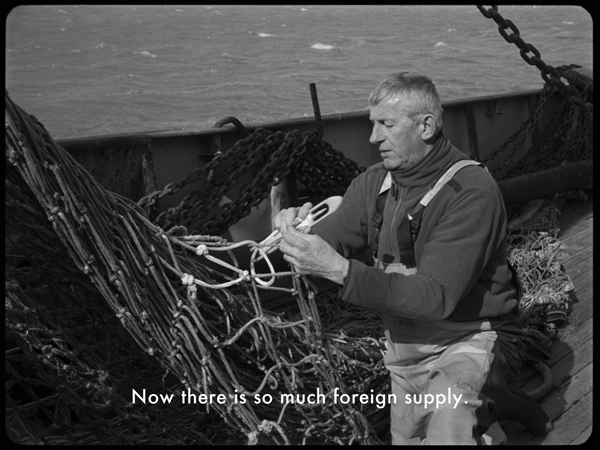
Video still of Episode by the Sea by Lonnie van Brummelen and Siebren de Haan
In the antechamber of the exhibition there is a parable.[1] For centuries the fisherfolk of Urk lived on an island in the middle of the Zuidersee. Then in 1932 the Dutch government decided to build dikes against the ocean. The island is now anchored on dry land. It must have been as if the world had turned upside down. Yet the film Episode of the Sea, by Lonnie van Brummelen and Siebren de Haan, does not really explain why the fisherfolk of Urk remained attached to their ancient trade. Instead it is all about the present. Images of nets tell a story of deep entanglement in the regulations of the European Union. You are encountering an age-old way of life that has always had to deal with human transformations of the environment.
How to face the natural crisis of global society? How to engage with the overwhelming material conditions of the Anthropocene? In the year 2014, awareness of human-induced global warming seemed to reach a kind of planetary tipping-point. Yet earlier experiences like the Fukushima meltdown, the BP oil spill or the flooding of New Orleans show that profound shocks to consciousness can be erased by dull, everyday reinforcements of the industrial norm. The point is to go beyond just reacting to the next inevitable flood or blowout. If we want to break the cycle of disaster, public outcry and induced denial, then changes in our mental maps, or indeed, in our shared cosmologies, must be followed by transformations of our social institutions. Maybe it’s not such a bad idea to begin exactly where World of Matter does, with the institutions of representation.[2] At stake is the relation between the capacity to make images of worldly things and the capacity to remake an inhabitable world.
I’d like to kick off this review with a philosophical proposal. The link between image and world is at the heart of what the philosopher Cornelius Castoriadis calls the “imaginary institution of society.” For him, the radical imaginary is “the capacity to posit that which is not, to see in something that which is not there.”[3] But the question is not whether this is done, for all societies are so instituted. The question is what do we invent, how do we see the world? How do we institute a new territory, a new reality? If we could learn to perceive other things than the objects of our desires, other beings than ourselves alone, then the radical imagination could provide the missing key to a currently unthinkable planetary democracy. For Castoriadis, emancipation is the process whereby the collective self (autos) creates its own laws (nomos). This is done, not only through negotiation over meaningful words, but also through the circulation of affective images. As he writes: “I call autonomous a society that not only knows explicitly that it has created its own laws but has instituted itself so as to free its radical imaginary and enable itself to alter its institutions through collective, self-reflective, and deliberate activity.”[4]
Today the societies of the so-called developed world have no such autonomy. We cannot even imagine the collectivity, let alone the laws or the norms that could resolve the natural crisis of global society. The very possibility of change remains invisible, like a spirit in a rock that you can’t see. Yet that missing spirit may have everything to do with your own material survival. A foundational role awaits for artistic images at grips with the planetary real.
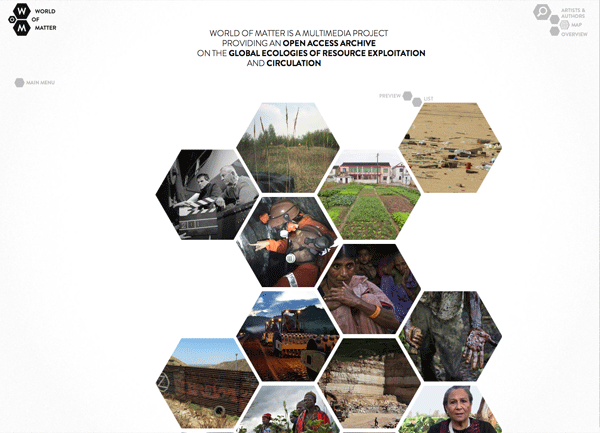
World of Matter online platform
The exhibition and web platform World of Matter follows crisscrossed paths through a number of major processes whereby humans are transforming the land, the water and the atmosphere. For this ongoing visual research, a core group of some ten authors carries out documentary probes, cartographic renderings, scientific explorations and juridical analyses of worldly matters that include oil and mineral extraction, industrialized and organic agriculture, dams, water-works and fisheries. The results so far have been shown in Dortmund, Germany, at the CUNY Graduate Center in New York and the Concordia University in Montreal, with further showings coming up in Stockholm and Minneapolis.[5] The majority of the videos, photographs, maps and texts can be consulted at www.worldofmatter.net. They focus on human and non-human actors, at scales from macro to micro.
Let’s start from the beginning: Ursula Biemann’s Egyptian Chemistry, which opens the tightly packed exhibition in New York. We’re greeted by a display of laboratory flasks and beakers, echoing a video image projected high against the back of the gallery, showing a white-coated scientist manipulating the same equipment. A tracery of the meandering Nile runs laterally along deep blue walls, guiding the eye toward a lower projection that shows casually dressed locals gathering water samples from the river bank. To the right, three small monitors hang in a row, head high, each with dangling headphones. The invitation is clear: it’s time to take the plunge into complex narratives. At stake in each fragmentary sequence is the overwhelming agency of the river, whose bounteous and destructive floods have given rise to the water-management projects of successive “hydraulic civilizations.” How does the Nile flow today?
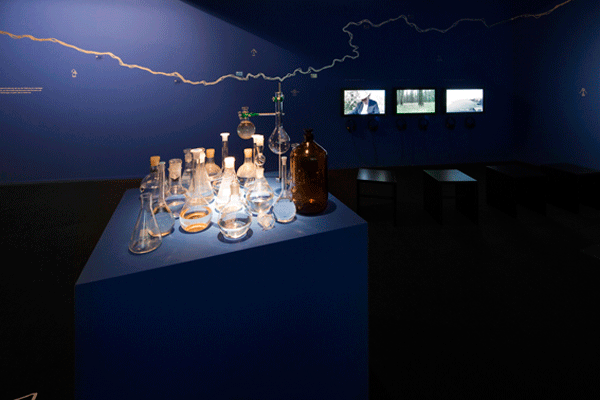
Installation shot of Egyptian Chemistry in World of Matter exhibition at Hartware Dortmund, 2014, photograph by Hannes Woidich.
With delicately chosen documentary clips informed by off-screen or full-face interviews, the videos tell of dam-building campaigns, irrigation technologies, peasant struggles in the countryside and scientific testing and modeling of the river’s currents. The atmospheric physicist Carl Hodges describes utopian schemes to plant carbon-absorbing mangroves in seawater canals for the production of food, animal feed and biofuels. Standing ankle deep in the tide with his sport coat and jaunty leather hat, Hodges rejoins the long line of Faustian inventors and developers portrayed in Marshall Berman’s scathingly critical book, All That Is Solid Melts Into Air. A scandalous sense of hubris gathers around those who want to change the very face of the earth, or in this case, to lay their own hand on the waters. Yet in the face of famines and penuries to come, one can also feel inspired by this visionary scientist.
Other modernization campaigns – like making the desert bloom with irrigation and antibiotics – do not look anywhere near so good. We see the tubes and wheels of an automated sprinkler rolling across parched soil like the skeleton of some silvery dinosaur. Eschewing pyramids or mummies and looking from the present to the future, Biemann evokes the processes of coevolution that have fashioned the Egyptian landscape. Inside a warehouse-like structure we see scale models of the flowing river and its associated control devices (dams, locks, hydroelectric power generators, etc). Fragmentary captions flash up on the screen: “Millennia of engineers / who measure and calculate / draw plans and build models.” We are being asked to conceive how the mind articulates vast material transformations.

Hydraulic Modeling. Video still of Egyptian Chemistry by Ursula Biemann, 2014
This show has it own very powerful philosophical debate, provided by thinkers like Michel Serres, Donna Haraway, Graham Harman, Timothy Morton, Jane Bennet and Bruno Latour. At the close of Ursula Biemann’s series, Harman himself appears against the chemical background of tear gas floating into the compound of Cairo’s American University where he teaches. The key concepts of his object-oriented ontology are evoked in a few phrases. “All knowledge is oblique, all knowledge is an allusion,” he says. “You can never get back to the absolute knowledge because you cannot translate a thing into any form of relation.” In this philosophy – which is also called “speculative realism” – objects inevitably withdraw from direct access. Things exist autonomously, on their own terms, without correlation to the human world; they are irreducible to the vagaries of our perception. Yet by the same token, “any real relation automatically becomes a new object” – that is to say, a mental phenomenon, a thing for humans, or what Castoriadis might call a figment of the radical imaginary. “That’s the political level,” Harman explains, wiping his eyes against the tear gas. “But I would also say that I do not feel the need to ground everything in politics. This idea that the cash value of any philosophy is its political virtues is in a way the last phase of correlationist philosophy.”
Cash values aside, it’s very hard to see how any valid philosophy could elude contemporary politics. But Biemann translates Harman’s thinking into her own exploratory practice, attentive to the complex actor-networks that shape the Nile ecology. The point is to pay attention to the things themselves, to look outside the closure of specific cultural frames. Then we become aware of new agencies. As we read on the gallery wall: “Metachemistry is a planetary narration that alludes to the earth as a mighty chemical body where the crackling noise of the forming and breaking of molecular bonds can be heard at all times.” So where does metachemistry touch political flesh?
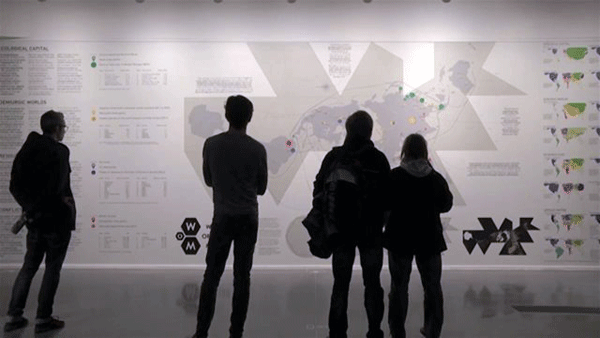
World of Matter, wall cartography by Peter Mörtenböck and Helge Mooshammer, Hartware Dortmund, 2014.
Turn the corner for one answer. A giant Dymaxion map spreads out above a vitrine filled with texts and objects. On Buckminster Fuller’s defamiliarizing cartography, Peter Mörtenböck and Helge Mooshammer have located container ship bottlenecks, rare earth deposits, oil and immigration choke points – geographical sites where the limits to global growth become starkly evident. Each dot on the map warns of future crises. “It is here that we find the call for a new ecological understanding coalescing with the call for a new political economy,” reads the wall text. Technoscience makes the molecular global. Case studies of disaster-prone environments are presented in the vitrines below, initiating us to a vertiginous telescoping of scales.
Take a few steps further: images of huge, highly rationalized fields spring into view. You’re flying in the air, you’re trapped inside an endless factory, you’re gazing on night-dark furrows stippled with bright flocks like snow. Below these large projections, a line-up of four small monitors guides you though a planet planted in cotton. From Brazil to India to Texas to Burkina Faso, Uwe Martin conducts reportage-style interviews with peasants, so-called “conventional” farmers, agro-ecological researchers, organic pioneers and the food activist Vandana Shiva. Gradually you realize that this distant subject is really very close to your own skin. The global scale shrinks down to the shirt you are wearing. The planter Gilsen Pinesso recounts how he transferred GMO methods from Brazil to the rich black soil of the Sudan, where he was invited by a government minister. For ten uncomfortable minutes, a cotton-grower from the Global South looks us straight in the eye and talks pure corporate strategy. “The Sudanese farmers will take some time to internalize all this know-how, all this technology,” he explains, predicting a ten-year lapse before they complete their rendezvous with capitalist destiny.
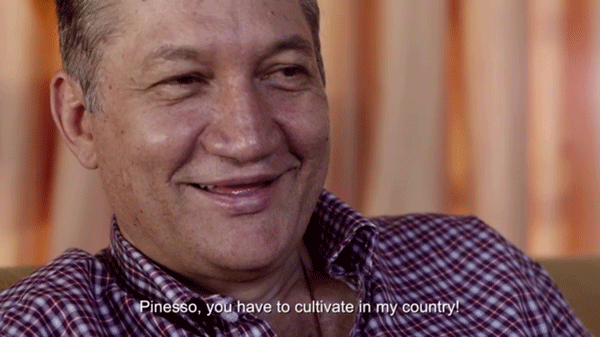
Video still of Land Rush by Frauke Huber and Uwe Martin, 2014
Those trained in the subtleties of contemporary art tend to shudder when they encounter this kind of blunt reportage. Rightly so: because it reveals, or even embodies, the banal and continuous violence that links us all into the contemporary division of labor.
In the past, vanguard political artists engaged their struggles by means of shocking divides, in symbolic portrayals of military conflicts, sexual rifts, labor hierarchies, commodity fetishes and excluded or self-assertive others. For them, ideology was understood in structuralist terms, as a violently deterministic relation between individual lives and fundamental symbolic categories. The role of the artist or theorist was to lift the veil of particulars and show these structures at work in your own life. At best, an existential breakthrough might open the floodgates of emancipation. The artists in World of Matter take a very different approach. They develop an ecological vision that includes human involvement at every turn. By focusing on concrete geographical relations such as the circulation of goods, technologies and scientific concepts, they trace out a metonymic skein that ultimately forces us to recognize ourselves as functioning parts of the global whole. The shock, if that’s still the word, comes not from a split but a suture. We are all Gilsen Pinesso, but each with our particular specialties. The coherence of the global system is the radical imaginary of contemporary capitalism itself: a pervasive just-in-time economy whose ubiquitous flow-objects are not only at your fingertips, but also inside you, as world-pictures that you continually recreate and propagate through your professional activity. Ideology is neither a veil nor a pair of heavy chains, but an actively maintained connection between endless sequences of images. At the root (at the radical level) the capitalist world economy is a socially instituted fiction.
Yet reality, as Harman reminds us, remains distinct from all merely human correlations. The strength of World of Matter is to present itself, not as fully integrated single narrative, but as distinct and recombinable files, fragmentary testimonies from a hearing that is still in progress. Its strength to let the world break down into real complexity, so that “the crackling noise of the forming and breaking of molecular bonds can be heard at all times.” So how does chemistry dissolve into materialist politics?
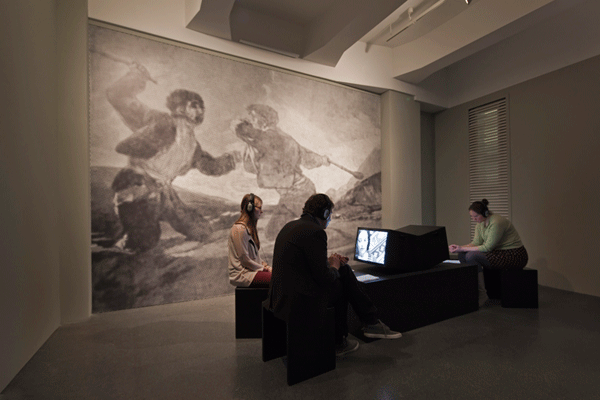
Installation shot of Nonhuman Rights by Paulo Tavares. Photography by Hannes Woidich.
Sit down to Paulo Tavares’ work: Non-Human Rights. Now you’re in for a long and fascinating journey through the indigenous struggles of the 1990s in Ecuador, leading up to the country’s new 2008 Constitution which recognized the rights of nature, or better, of La Pachamama. Scenes of rural protesters and landscapes devastated by oil and mineral extraction alternate with quotations from the Michel Serres’ 1900 book, The Natural Contract. Look at the settling ponds in the jungle, where Texaco pumped billions of gallons of toxic effluents from its wells. As indigenous activist Luis Macas recounts: “We’re fighting for something that has to do with life itself.” But that living reality is inseparable from a cultural idea. At the end of the video, Tavares addresses himself directly to the environmentalist Esperanza Martínez: “It is said that Modernity is that system in which there is one nature and various cultures, right? But what you are saying is different. There exist various different natures.” “Yes,” she replies. “Precisely as many as there are cultures.”
A subtle tension runs throughout this project, between the anthropological claim that human groups create their own distinct worlds and the central philosophical claim of object-oriented ontology, which is that reality withdraws from any merely human correlation. This contradiction between the two approaches becomes explicit in Tavares’ video, where the scenes of extractivist devastation are preceded by inter-titles evoking “object-oriented violence.” Again this is a reference to Michel Serres, who forcefully shows how human beings make war on the rest of the living world. But it is also an attack on object-oriented thinking. The implication is that philosophy must never neglect its ecological context, lest it participate in unbearable atrocities.
Nonetheless, Graham Harman’s philosophy is vindicated in this same work, although in terms he would probably not himself accept. For the “natural contract” of which it is question here springs into being through the recognition of hitherto ignored and discounted material things – rocks, trees, soil, air – which the indigenous people conceive as inseparable from “spirits of the forest.” There is foundational potential in that which withdraws from Western instrumental rationality.
I began this review with the notion of the radical imaginary: a raw psychic representation of the world which is normed and stabilized by social institutions, but which can also break away, reconfigure itself and take new roots among the community of living beings – on the condition that social institutions are themselves transformed to match the new vision. For Castoriadis, that transformation begins when individuals and groups start to recognize that the only guarantee of their own autonomy, of their own emancipation and pathway to a good life, is to be found in common norms and laws that guarantee good living for others. What World of Matter tries to do – with some help from both Michel Serres and the speculative realists – is to extend this democratic process to non-humans.

Video still of Museum of Public Concerns by Mabe Bethônico, 2014
Let’s close with a short proposal by Mabe Bethônico, an artist-researcher from Belo Horizonte, Brazil. It’s the “Museum of Public Concerns,” improvised on the ground in the face of the privatization of cultural institutions by mining companies in the Brazilian state of Minas Gerais. The recipe for institutional autonomy is disarmingly simple: involve sociologists, media theorists, anthropologists and artists in the creation of a mobile museum that could present precisely those things that corporate culture skips over – notably the histories of oil and mineral extraction. Plans unfold on the video screen for a DIY display structure that looks eminently practical. Only such an activist approach can deal with “matters of public concern.” Yet what else is World of Matter doing, on a website and in a university rather than out on the streets?
There may be an invitation here. Download the videos, put them in your bicycle- or solar-powered vehicle, and show them to everyone you meet. Treat them just like material things that have to do with life itself. It’s high time to make a break with our own normalized ways of creating and propagating world-pictures. Don’t imagine the apocalypse, that’s old hat. Just bring your radical imagination to focus on the end of global capitalism.
[1] A review of the show at CUNY Graduate Center, New York, September-November, 2014. World of Matter was presented by Ursula Biemann at the “Curating Everything” symposium.
[2] World of Matter is an international art and media project initiated by an interdisciplinary group of artists and scholars investigating primary materials and the complex ecologies of which they are a part. Participants include Mabe Bethônico, Ursula Biemann, Uwe Martin & Frauke Huber, Elaine Gan, Helge Mooshammer and Peter Moertenboeck, Emily Scott, Paulo Tavares and Lonnie van Brummelen & Siebren de Haan,
[3] C. Castoriadis, “The State of the Subject Today,” in World in Fragments: Writings on Politics, Society, Psychoanalysis, and the Imagination, tr. D. A. Curtis, (Stanford University Press, 1997), p. 151.
[4] C. Castoriadis, “Psychoanalysis and Politics,” ibid., p. 132.
[5] Exhibitions took place in the following venues: WORLD OF MATTER – On the Global Ecologies of Raw Material, at HMKV Dortmund, March-June 2014, and at James Gallery, CUNY Graduate Center, New York, September-November 2014; WORLD OF MATTER – Exposing Resource Ecologies, at Leonard and Bina Ellen Gallery, Concordia University Montreal, February-April 2015. World of Matter conferences run parallel to the exhibition opening. The World of Matter book is published by Sternberg Press Berlin/New York, 2015. http://events.worldofmatter.net
